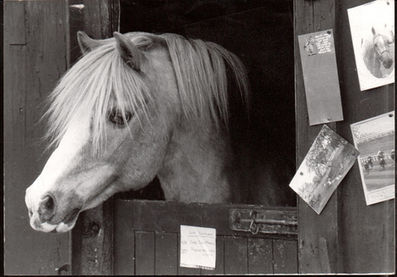Welsh Section C
THE WELSH PONY OF COB TYPE
Not exceeding 137.2 cm (13.2 hands)
Section C of the Stud Book
Detailed Description of Sections C (also applicable to Section D of the Stud Book)
General Character
Strong, hardy and active, with pony character and as much substance as possible
Colour
Any colour, except piebald and skewbald
Head
Full of quality and pony character. A coarse head and Roman nose are most objectionable
Eyes
Bold, prominent, and set widely apart
Ears
Neat and well set
Neck
Lengthy and well carried. Moderately lean in the case of mares, but inclined to be cresty in the case of mature stallions
Shoulders
Strong but well laid back
Forelegs
Set square and not tied in at the elbows. Long, strong forearms. Knees well developed with an abundance of bone below them. Pasterns of proportionate slope and length. Feet well-shaped. Hoofs dense. When in the rough, a moderate quantity of silky feather is not objected to, but coarse, wiry hair is a definite objection.
Middlepiece
Back and loins, muscular, strong, and well-coupled. Deep through the heart and well-ribbed up.
Hind Quarters
Lengthy and strong. Ragged or drooping quarters are objectionable. Tail well-set on.
Hind Legs
Second thighs, strong and muscular. Hocks, large, flat, and clean, with points prominent, turning neither inward nor outwards. The hind legs must not be too bent, and the hock not set behind a line falling from the point of the quarter to the fetlock joint. Pasterns of proportionate slope and length. Feet well-shaped. Hoofs dense.
Action
Free, true and forcible. The knee should be bent and the whole foreleg should be extended straight from the shoulder and as far forward as possible in the trot. Hocks flexed under the body with straight and powerful leverage.
History
The Section C developed as a lighter and smaller counterpart of the Welsh Cob Section D, that retained the strong characteristics of the Welsh Cob but in a smaller, more 'pony-like' package. The section really grew to prominence with the crossing of Welsh Mountain Ponies and Welsh Cobs after the War, and they became popular as an intermediate pony between the slightly smaller and more slender Welsh Section B and the often quite tall, and stocky Welsh Cob. Today, the Welsh Section C is an ideal stepping stone for those looking to move from smaller ponies into larger and more powerful cobs and horses - owning a Welsh Section C will give the impression of owning a Welsh Cob in a smaller package, but with no less of the Welsh Spirit!
Uses
Their true worth as a dual-purpose animal has been fully realised in recent years, and their numbers have increased accordingly. Active, surefooted, and hardy, they are ideal for so many purposes both for adults and children.
Like all the Welsh Breeds they are natural jumpers, and they also excel in harness — there are in fact few things that they cannot be used for. They are the ideal pony for those looking for a manageable sized animal that is suitable for the whole family. Suited to jumping, driving and showing, as well as for enjoyment outside of the competition ring, the Welsh Section C is a very versatile pony indeed.












